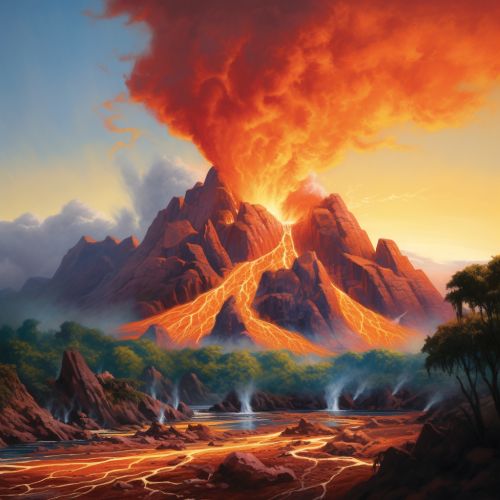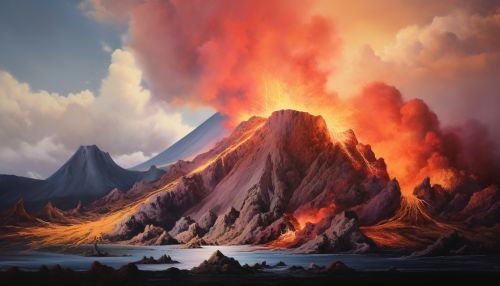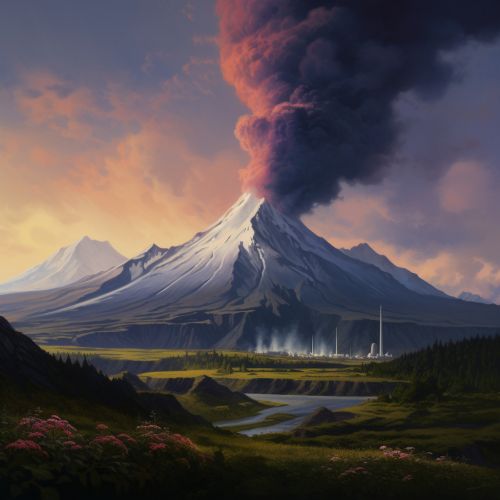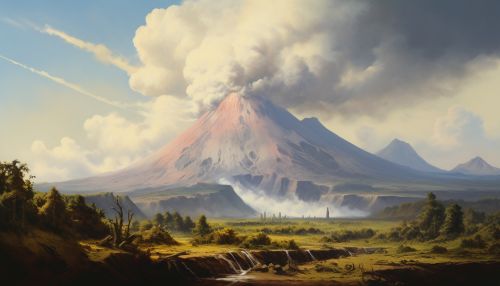Volcanism and Landscape
Introduction
Volcanism is the phenomenon of eruption of molten rock (magma) onto the surface of the Earth or a solid-surface planet, where lava, pyroclastics and volcanic gases erupt through a break in the surface called a vent. It includes subaqueous volcanic activity into the deep sea, causing seamounts and other submarine landforms. The term volcanism refers to both the processes associated with the eruption of magma and the modes and characteristics of volcanic eruptions themselves. Volcanism is responsible for creating not only volcanic islands such as Iceland and the Hawaiian Islands, but also dramatic landscapes such as the Columbia Plateau in the Pacific Northwest of the United States.


Volcanic Landforms
Volcanic landforms are controlled by the geological processes that form them and act on them after they have formed. Thus, a given volcanic landform will be characteristic of the types of material it is made of, which in turn depends on the prior eruptive behavior of the volcano. The types of behavior and the types of material are both controlled by a range of factors, including the chemistry, temperature and viscosity of the magma, the types of gases within the magma, and the mode of eruption.
Volcanic Cones
Volcanic cones or cinder cones result from eruptions of mostly small pieces of scoria and pyroclastics (both resemble cinders, hence the name of this volcano type) that build up around the vent. These can be relatively short-lived eruptions that produce a cone-shaped hill perhaps 30 to 400 meters high. Most cinder cones erupt only once. Cinder cones may form as flank vents on larger volcanoes, or occur on their own. Parícutin in Mexico and Sunset Crater in Arizona are examples of cinder cones. In New Mexico, Caja del Rio is a volcanic field of over 60 cinder cones.
Stratovolcanoes
Stratovolcanoes or composite volcanoes are tall conical mountains composed of lava flows and other ejecta in alternate layers, the strata that give rise to the name. Stratovolcanoes are also known as composite volcanoes because they are created from multiple structures during different kinds of eruptions. Strato/composite volcanoes are made of cinders, ash, and lava. Cinders and ash pile on top of each other, lava flows on top of the ash, where it cools and hardens, and then the process repeats. Classic examples include Mount Fuji in Japan, Mayon Volcano in the Philippines, and Mount Vesuvius and Stromboli in Italy.


Shield Volcanoes
Shield volcanoes, so named for their broad, shield-like profiles, are formed by the eruption of low-viscosity lava that can flow a great distance from a vent. They generally do not explode catastrophically. Since low-viscosity magma is typically low in silica, shield volcanoes are more common in oceanic than continental settings. The Hawaiian volcanic chain is a series of shield cones, and they are common in Iceland, as well.
Volcanic Activity and Landscape
Volcanic activity is a major force in changing landscapes. Over time, the repeated eruption of lava and pyroclastic material creates layers of deposits that can build up into a volcanic mountain or plateau. The eruptions can also create other features such as craters, calderas, and volcanic plugs. The landscape around active volcanoes is often dramatically changed by the effects of weathering and erosion on the volcanic deposits. This can create a range of landforms, from jagged peaks and steep-sided gorges to wide plains and gentle hills.
Weathering and Erosion
Volcanic landforms are often subject to weathering and erosion, which can dramatically change the landscape over time. Weathering is the breaking down of rocks, soils and minerals through contact with the Earth's atmosphere, water, and biological organisms. Erosion is the process by which weathered rock and soil are moved from one place to another. Weathering and erosion can create a variety of landforms, including cliffs, valleys, hills, channels, and floodplains.
Volcanic Soils
Volcanic soils, also known as andisols, are fertile soils that form in volcanic ash and other materials. These soils can support a wide variety of plant life, which in turn can affect the landscape by stabilizing slopes, influencing water runoff, and creating habitats for animals. The fertility of volcanic soils makes them important for agriculture, supporting crops such as coffee, cocoa, and vineyards.
Impact on Human Activity
Volcanic activity can have both positive and negative impacts on human activity. On the positive side, volcanic soils are often very fertile and are good for farming. Volcanic activity can also create valuable resources such as geothermal energy and minerals. On the negative side, volcanic eruptions can be dangerous and deadly, causing damage from lava flows, ash fall, and pyroclastic flows. They can also cause indirect problems such as climate change and disruption to air travel.
Conclusion
Volcanism plays a crucial role in shaping the Earth's landscapes. From the creation of towering mountains and vast plateaus to the formation of fertile soils, the processes associated with volcanism have a significant impact on the physical geography of our planet. Understanding these processes and their effects on the landscape is not only important for scientific research, but also for managing natural resources and mitigating natural hazards.
